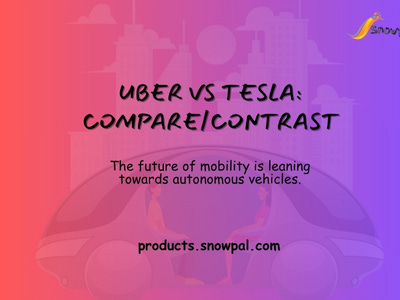Uber vs Tesla: Compare/Contrast
Robotaxis pose a potential threat to Uber's business model. Uber generates significant revenue from ride-sharing and delivery services. The future of mobility is leaning towards autonomous vehicles.
In this podcast, Krish Palaniappan discusses the evolving landscape of finance and technology, focusing on the business models of Tesla and Uber. He explores Tesla's expansion into Robotaxis and its implications for Uber's ride-hailing services. The conversation delves into market performance, sales analysis, and the competitive edge provided by data and technology. The episode concludes with financial insights into both companies and a look at future prospects in the mobility sector.
Takeaways
Tesla's business model includes electric cars, energy, and robotaxis.
Uber generates significant revenue from ride-sharing and delivery services.
Robotaxis pose a potential threat to Uber's business model.
Tesla's valuation is heavily influenced by its EV sales.
Uber's revenue is diversified across multiple segments.
Data and technology play a crucial role in competitive advantage.
The future of mobility is leaning towards autonomous vehicles.
Both Tesla and Uber are navigating a rapidly changing market.
Podcast
Summary
🎙️ 1. Introduction
Motivation: Solving real-life problems the team encounters, rather than seeking problems artificially.
🚀 2. Podcast Evolution & Goals
Podcast rebranded to cover finance alongside engineering.
Announcement of a goal to produce 100 podcasts by end of 2025.
Plans to include interviews with AI founders and hands-on solo podcasts.
🚖 3. Topic Introduction: Uber vs Tesla
Central question: Could Tesla’s Robotaxis threaten Uber’s business?
Context on Tesla launching Robotaxis in Austin.
Parallel exploration of Tesla’s and Uber’s business models.
⚡ 4. Tesla’s Business Breakdown
Tesla’s four key segments:
Electric Vehicles
Energy business
Robotaxis
Optimus robots
Tesla sold ~1.7 million vehicles globally in 2024; ~33% sold in the US.
Revenue details: ~$97 billion annual revenue.
Noted Tesla’s extensive driving data (~100 billion miles), giving it a major AI training advantage.
🚕 5. Uber’s Business Breakdown
Uber’s three key revenue segments:
Mobility (ride-sharing): ~57% of revenue
Delivery (Uber Eats): ~31%
Freight: ~11%
Uber completes ~28 million rides per day globally, with over 2.6 billion rides to date.
CEO’s confirmation that human drivers remain essential in the near term.
US revenue contributes ~60% of Uber’s total revenue.
🦾 6. Robotaxis vs Uber: Competitive Dynamics
Robotaxis could directly threaten Uber’s mobility segment (~57% of revenue).
Tesla has the advantage of vertical integration (full stack: software, hardware, data).
Uber must partner with AV manufacturers; lacks Tesla’s control and data ownership.
Comparison with Waymo:
Waymo completed ~10 million rides vs Uber’s 2.6 billion.
Waymo vehicles cost $200k each; Tesla’s cars are far cheaper ($30k–$35k).
🔍 7. Geographic and Technical Considerations
Discussion on AV adoption challenges in countries like India, where road conditions pose unique difficulties.
AV rollout likely to begin in countries like the US, China, Japan, South Korea, and Europe.
📊 8. Financial Comparisons & Stock Metrics
Tesla:
Share price ~$315
PE ratio: 170
Valuation: ~$1 trillion
Short interest: ~2.3%
Uber:
Valuation: ~$200 billion
PE ratio: ~30–32
Short interest: ~2%
Uber’s US mobility revenue exposure: ~$50 billion directly threatened by Robotaxis if adoption becomes widespread.
💡 9. Future Outlook & Questions
Will Tesla’s Robotaxis cause the decline of Uber’s US ride-hailing business?
Short-term view: Uber isn’t immediately under threat; mid-to-long-term could see significant disruption.
Calls for listener opinions on whether Tesla and Uber will coexist or if Uber’s ride-hailing business is fundamentally at risk.
🔔 10. Conclusion & Call to Action
Podcast wraps with an invitation to listeners to connect on finance and FinTech topics.
Encourages collaboration or investment in Snowpal’s ongoing projects.
Directs listeners to products.snowpal.com for more information on products, APIs, courses, and podcasts.
Transcript
Snowpal Products
Backends as Services on AWS Marketplace
Mobile Apps on App Store and Play Store
Web App
Education Platform for Learners and Course Creators



